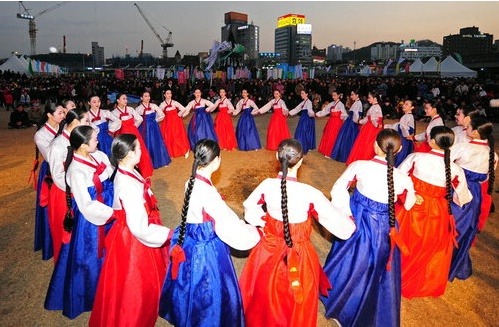Pak-Korea Culture
21 April 2017
18 November 2013
14 January 2011
Sharing Intangible Heritage of Korea with the World- Click for Details
The Cultural Heritage Administration of Korea (CHA) produces DVDs on intangible cultural heritage of Korea inscribed on the UNESCO Intangible Cultural Heritage List. DVDs will be distributed to relevant organizations and researchers in Korea and overseas; public online access will be provided as well. It is expected to help understanding on intangible cultural heritage of Korea further contributing to create a higher brand value of Korea.
Would you like a bowl of Ttukbaegi? Click here for Detail
Onggi, a traditional Korean pottery, has had a significant role as a food container in the Korean food culture. Not simply a plain pot it is recognized for its scientific principles; especially its breathing holes that remove toxic substance of foods and reduce the smell.
20 December 2010
The Times 50 Best Inventions of 2010 - Click here for detail
The Online Electric Vehicle (dubbed OLEV) manufactured by the Korea Advanced Institute of Technology (KAIST) was included in the 50 Best Inventions of 2010 published by The Times, along with Apple’s iPad, Google’s Driverless Car, Sony’s Alpha A55 Camera and others. Also included was the English-Teaching Robot invented by the Korea Institute of Science and Technology (KIST). The Times introduced the OLEV as an advanced green growth technology that could speed up the commercialization of electric cars. As for the robots, they can effectively teach young students how to pronounce English words; they can move in any direction, follow human facial expressions, and students actually enjoy interacting with this “cool” new staff. Read more about it!
Foreign Journalists Visit Jeju Island Click here for detail
20 Seoul-based foreign journalists on last November 19 and 20 visited Jeju Island as part of their press tour program sponsored by the Korean Ministry of Culture, Sports and Tourism. They had their first impressive encounter with Jeju haenyeo (sea women) who dive 20m deep into the ocean and collect sea products, holding their breath for as long as two minutes. The journalists also walked the famous Jeju Olle Road which exhibits a scenic view of cliffs and the sea. And of course, can’t forget the sumptuous meal composed of just-caught Jeju sea food and makgeolli. Read more about their Jeju trip!
01 December 2010
Korean Grafted Cactus Fascinates the World - Click here for detail
The Rural Development Administration (RDA) exhibited its newly developed grafted cactus at the horticulture fair held last November 11. The Korean grafted cactus has been garnering excellent reviews from the worldwide horticulture market with its annual volume of export exceeding USD 2 million to over 30 countries. Contrary to the usual association of cactus (some thorny, misshapen, rough-looking plant standing under the scorching sun in the desert), Korean cactus comes in numerous splash colors (red, pink, yellow, orange etc) and sizes (a cute little cauliflower-like thing the size of your fist). Read more about it.
Korea on the Road to First Class - click here for detail
Chairwoman Lee Bae-Yong of the Presidential Council on Nation Branding gave a lecture on the subject of Korea’s nation branding for the KBS program “The Road to First Class.” Lee emphasized that Korea’s astounding growth in the 20th century was possible only because it was backed up by the country’s such timeless virtues as perseverance, cooperative and pacifist inclination, modesty, warmhearted regards for life and nature, harmony and sharing. Lee also stressed the importance of promoting historic and cultural heritages in raising Korea’s global status. Read more about it.
16 November 2010
Korea’s Women of the Sea ("Haenyeo") Click here for detail
"Haenyeo" (the sea women) are female divers in the Korean province of Jeju. What used to amount to as many as 15,000 haenyeo in 1970 has now plummeted to a mere third of that number; and most of them are over seventy years of age, meaning that haenyeo are fast disappearing. Nowadays, instead of the strenuous lifestyle as a haenyeo, many Jeju women are turning elsewhere for other possibilities of living. In light of this sad reality, The LA Times published a feature article on Korean haenyeo, including interviews with the youngest haenyeo in Korea (33-year-old Ms. Kim) who has chosen the harsh path so that the precious tradition could be preserved.
Cycling at the National Parks of Korea
The Korea National Park Service announced that they are going to add four more cycling courses to the existing four, so operating a total eight routes.
In the cycling programs offered at the Hallyeohaesang National Park and the Deogyusan National Park, you can rent bicycles for free at the respective park offices.
The Korea National Park Service is planning to create extra cycling courses of 20km at the four parks including Seoraksan, Naejangsan, Jirisan and Woraksan
Choose a Course that Is Right for Your Capacity
Choose a Course that Is Right for Your Capacity
When cycling, it is important to choose a course that fits your strength and skills, and also to be mindful of safety instructions.
For example, if you are on a downhill road, you shouldn’t exceed 10km/h by applying hand brakes. As is common sense, you must wear a helmet as well as restrain from using mobile phones or ear plugs to listen to music. And also, should the unfortunate situation happens where on a downhill you’ve lost control of your bicycle, then you should rather let go of the handles instead of holding tight on to them, which is usually the instinct.
Remember, abiding safety rules aren’t only about your own safety; it’s as much about other cyclists and hikers’ who are near you.
If you are one of those who aren’t really into the taxing, energy-consuming hiking business, then you might want to consider trying a cycling program at the national parks!
Subscribe to:
Posts (Atom)















